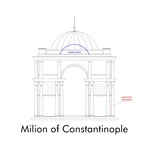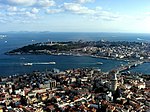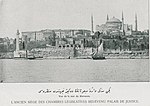Milion

The Milion (Greek: Μίλιον or Μίλλιον, Míllion; Turkish: Milyon taşı) was a monument erected in the early 4th century AD in Constantinople (modern-day Istanbul, Turkey). It was the Byzantine zero-mile marker, the starting-place for the measurement of distances for all the roads leading to the cities of the Byzantine Empire. It thus served the same function as the Golden Milestone (Milliarium Aureum) in Rome's forum. The domed building of the Milion rested on four large arches, and it was expanded and decorated with several statues and paintings. It survived the Fourth Crusade and Ottoman conquest of Constantinople in 1453 but had disappeared by the start of the 16th century. During excavations in the 1960s, some partial fragments of it were discovered under houses in the area.
Excerpt from the Wikipedia article Milion (License: CC BY-SA 3.0, Authors, Images).Milion
Divanyolu Caddesi, Istanbul
Geographical coordinates (GPS) Address External links Nearby Places Show on map
Geographical coordinates (GPS)
| Latitude | Longitude |
|---|---|
| N 41.008041666667 ° | E 28.978066666667 ° |
Address
Milyon Taşı
Divanyolu Caddesi
34122 Istanbul
Türkiye
Open on Google Maps








